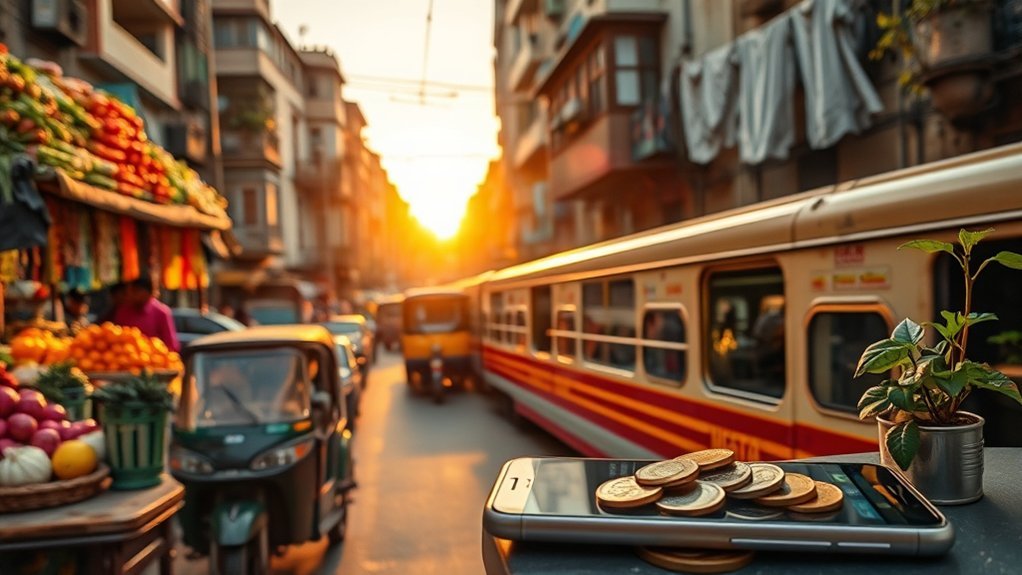You can live in an Indian metro on roughly ₹40,000–₹50,000 a month as a single person, while a family of four typically needs at least ₹1,00,000 monthly excluding rent. Rent varies widely — ₹5,000–₹60,000 across cities — and groceries run ₹2,100–₹9,000 depending on household size. Utilities average about ₹3,500 and transport around ₹942 per month; healthcare and childcare add extra. Choose city and lifestyle carefully to control costs, and more specifics follow.
Average Monthly Budget for Individuals and Families
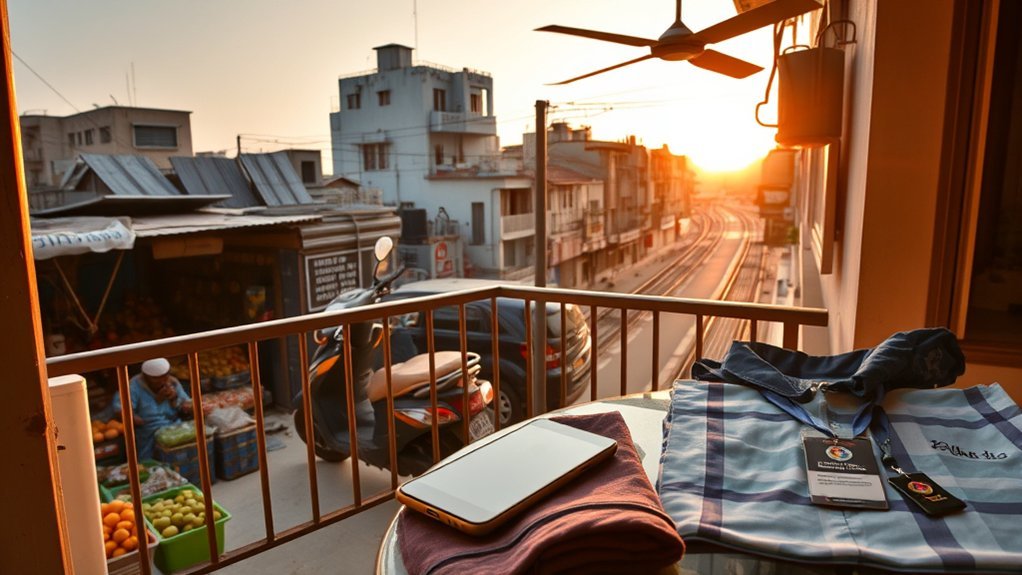
While exact needs vary by city and lifestyle, you can expect a single person in an Indian metropolitan area to live comfortably on about ₹40,000–₹50,000 per month, and a family of four to need at least ₹1,00,000 monthly (excluding rent) to maintain a comparable standard of living.
You’ll use that monthly budget to cover the core components of the average cost of living: grocery prices, utilities, healthcare costs, and transport. Grocery prices range broadly—₹2,100 to ₹9,000 depending on household size—so your food share will scale with family size.
Utilities average about ₹3,508 and transport roughly ₹942, both relatively stable across metropolitan areas. Healthcare costs average ₹1,713 per person monthly, so a family of four should allocate around ₹6,852 for medical expenses.
If you’re budgeting, prioritize recurring essentials first, then adjust discretionary spending. This analytical breakdown helps you forecast cash flow and set a realistic buffer for inflation or unexpected costs.
Housing and Rental Prices Across Major Cities
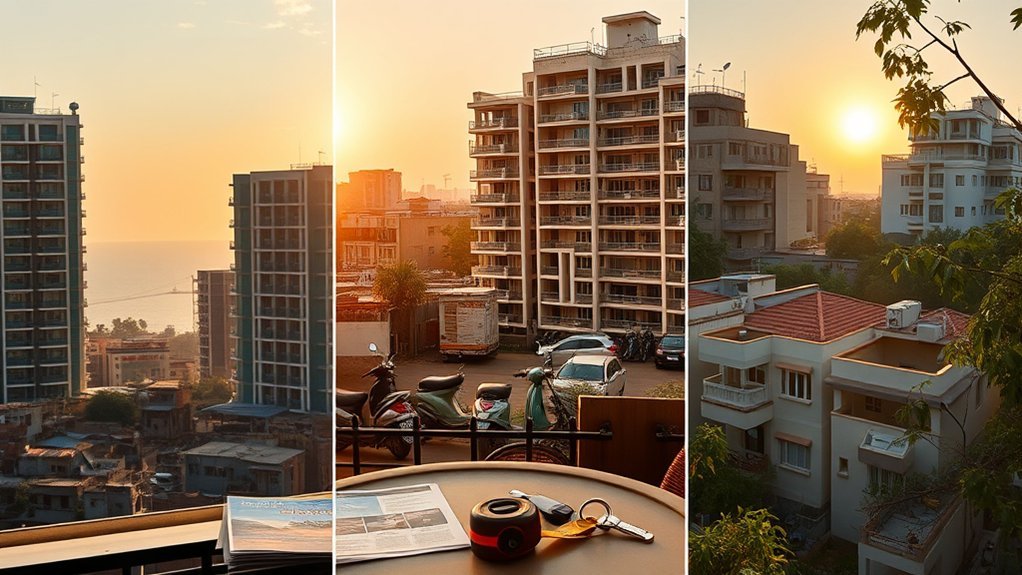
Once you’ve set your monthly budget for groceries, utilities and healthcare, housing typically becomes the single largest variable in that plan, so it’s where you’ll need the most detailed costing. You should expect wide rental prices: Mumbai (₹6,000–₹40,000) ranks among the most expensive cities; Delhi ranges even wider (₹5,000–₹60,000) by neighborhood and unit type. Bangalore and Pune show mid-tier variability (Bengaluru ₹7,000–₹30,000; Pune ₹15,000–₹25,000). Chennai overlaps with Mumbai at ₹6,000–₹40,000 but offers more affordable options in select zones. Smaller cities like Bhopal and Vadodara present cost-efficient housing, roughly 96% cheaper than New York, ideal if you prioritize lower rent over metropolitan amenities.
| City | Typical monthly rent (₹) |
|---|---|
| Mumbai | 6,000–40,000 |
| Delhi | 5,000–60,000 |
| Bangalore/Pune | 7,000–30,000 / 15,000–25,000 |
| Chennai/Bhopal/Vadodara | 6,000–40,000 / much lower (affordable options) |
Food, Groceries, and Daily Living Expenses
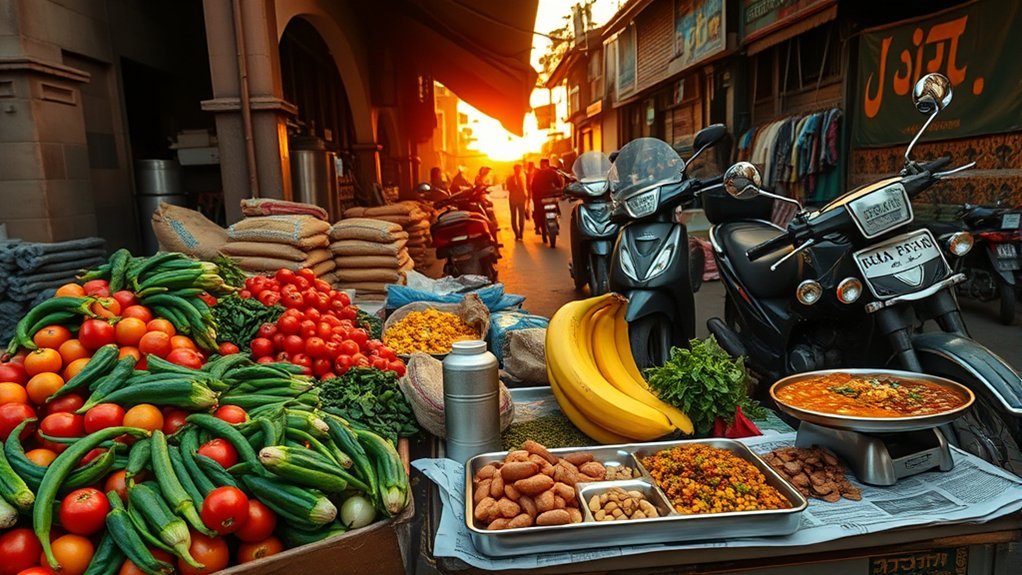
Because your grocery and daily bills vary with city and household size, plan a monthly food budget between roughly ₹2,100 and ₹9,000. Staples help illustrate this range—milk (1L) ≈ €0.60, bread (500g) ≈ €0.40, and chicken breast (1kg) ≈ €2.60—while eating out remains affordable (fast food ≈ €3.50; mid-range lunch ≈ €6; street food ≈ €2).
You’ll find groceries priced low in smaller cities and higher near major metros, so use the ₹2,100–₹9,000 band to model scenarios for single, couple, and family households. Track food categories: staples, fresh produce, protein, and packaged goods, then compare weekly vs. monthly buys to optimize spending.
Eating out is a flexible buffer—frequent fast-food or street-food trips keep costs predictable; occasional mid-range meals raise expenses. Include utility costs (electricity, water, gas) averaging about ₹3,507.65 monthly when calculating total daily living expenses.
Convert totals to Indian rupee and a foreign currency for clarity if you’re moving, then adjust estimates for dietary preferences and local price volatility.
Transportation and Commuting Costs
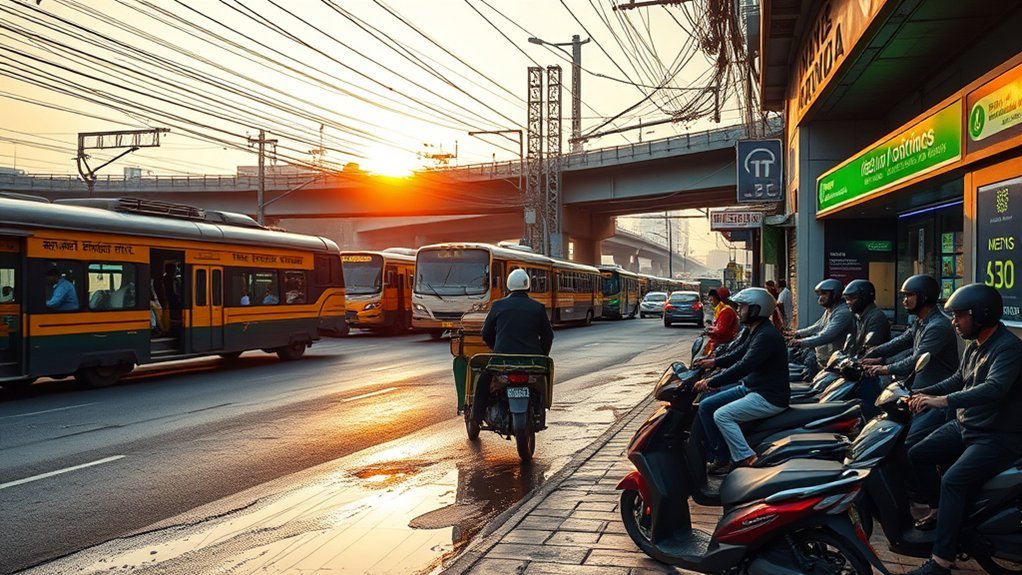
Expect to spend about ₹942 per month on public transit in India on average, though your actual cost will hinge on distance, frequency, and city—metros like Mumbai often mean denser crowds and longer travel times.
You’ll find transportation affordability strong: buses and trains keep commuting costs low, making public transport the default for most urban areas. Ride-sharing services and local taxis are convenient but raise your average monthly costs if used regularly.
- Public transport: lowest-cost option; predictable monthly spend (~₹942).
- Ride-sharing services/taxis: flexible, higher per-trip cost; useful for off-peak or last-mile.
- Personal vehicle ownership: highest long-term commuting costs (fuel, maintenance, parking).
Analyze your routine: short, frequent trips favor season passes and metros; irregular schedules push you toward ride-sharing and higher expenses.
Urban areas with heavy demand will increase time cost and occasional surcharges. Use this data to model realistic monthly commuting costs and choose modes that match your affordability threshold.
Healthcare, Insurance, and Education Expenses
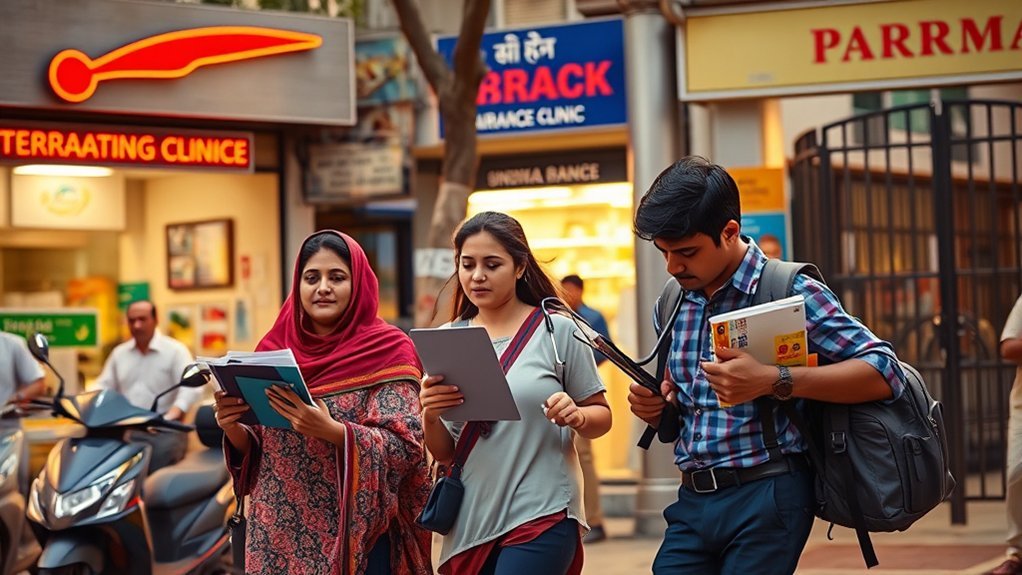
Although healthcare in India tends to be far cheaper than in many Western countries, you’ll still see wide variation: average out-of-pocket medical costs are about ₹1,713 per person, but location, chronic conditions, and whether you use public or private facilities can push that much higher.
Healthcare in India is generally cheaper, but out-of-pocket costs vary widely—about ₹1,713 on average per person.
You’ll rely on a mixed healthcare system: public healthcare offers low-cost basic services, while private providers give faster, higher-quality care. About 36% of Indians—and most expatriates—choose private health insurance, which lowers unexpected bills and wait times; without it you face greater out-of-pocket risk.
Education costs also vary: childcare expenses in metros run roughly ₹15,000–₹30,000 monthly, and student monthly expenses fall between ₹22,300 and ₹38,700 depending on city and housing.
When budgeting, treat health insurance premiums and regular medical spending as fixed monthly expenses and factor education and childcare as predictable, high-impact line items. That analytical split helps you model realistic living costs and assess trade-offs between public healthcare reliance and private health insurance.
How City Choice and Lifestyle Affect Your Budget

When you pick a city and set lifestyle choices, your monthly budget shifts dramatically: metropolitan hubs like Mumbai and Delhi typically push living costs into the ₹30,000–₹60,000 range while smaller cities such as Vadodara or parts of Chennai can be far cheaper.
You should align expectations: a family of four often needs ~₹1 Lakh monthly, but city choice and lifestyle choices drive variance.
- Rent impact: studio rent prices in Mumbai (₹20,000–₹40,000) vs Chennai (₹6,000–₹40,000) shows housing dominates budgets in expensive Indian cities.
- Food and essentials: monthly grocery bills (₹2,100–₹9,000) rise in metros; choose local markets and cooking patterns to reduce costs.
- Mobility: transportation costs average ₹942.38 but jump if you rely on private vehicles; factor commute distance and mode into total living expenses.
Use these levers—housing, groceries, transport—to model scenarios and optimize your budget precisely.
Frequently Asked Questions
How Much Money Is Needed to Live Comfortably in India?
You’ll need about ₹40,000–₹50,000 monthly solo or ₹1,00,000+ for a family; cost of living reflects housing prices, monthly expenses, food affordability, transportation costs, healthcare services, and entertainment options.
Is It Cheap for Americans to Live in India?
Like finding a bargain treasure, yes — Cost comparison shows it’s cheaper for Americans: Lifestyle expenses drop, Housing options and Food prices are low, Transportation costs minimal, Entertainment expenses modest, and Healthcare affordability often improves your budget.
How Far Does 1000 USD Go in India?
$1,000 stretches well: you’ll compare cost comparison metrics, cover living expenses across housing options, food prices, transportation costs and healthcare, benefit from currency exchange, and set a daily budget around $30–$33 for comfortable living.
How Far Does $500 USD Go in India?
You can stretch $500 for about a month in India: budget travel works if you choose modest accommodation types, control daily expenses, compare cost comparison data on food prices, transportation costs, and adjust lifestyle choices accordingly.
Conclusion
You can live in India on a surprisingly wide range of budgets: modest needs might cost $250–$500/month in smaller cities, while comfortable urban living in Mumbai or Delhi often runs $800–$2,000+. Don’t assume quality requires big spending — public healthcare, efficient local transport, and affordable markets keep costs low if you adapt. Choose your city and lifestyle deliberately, track expenses, and you’ll control your cost of living rather than let it control you.

